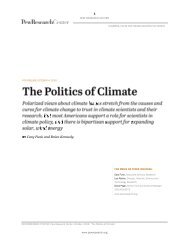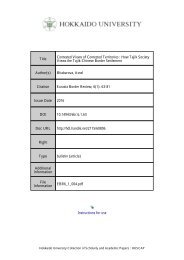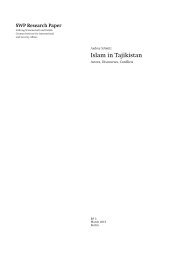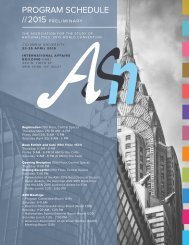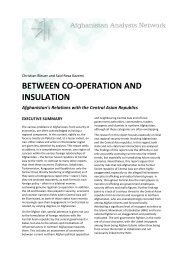Afghanistan in 2015 1
mM5Zmj
mM5Zmj
Create successful ePaper yourself
Turn your PDF publications into a flip-book with our unique Google optimized e-Paper software.
30<br />
<strong>Afghanistan</strong> <strong>in</strong> <strong>2015</strong><br />
End Notes<br />
1<br />
Intercept <strong>in</strong>terviews are a technique used to access volatile, <strong>in</strong>secure, and <strong>in</strong>accessible districts. Afghans who live<br />
<strong>in</strong> these districts are “<strong>in</strong>tercepted” while travel<strong>in</strong>g <strong>in</strong> a bazaar or district that is secure. Because this group cannot be<br />
chosen us<strong>in</strong>g random household selection, it is dist<strong>in</strong>guished from the ma<strong>in</strong> sample. Responses given dur<strong>in</strong>g <strong>in</strong>tercept<br />
<strong>in</strong>terviews are a valuable po<strong>in</strong>t of comparison because they <strong>in</strong>dicate whether security has an impact on responses, and<br />
<strong>in</strong> what direction. Intercept <strong>in</strong>terviews were conducted <strong>in</strong> 25 prov<strong>in</strong>ces. Prov<strong>in</strong>ces with the highest use of <strong>in</strong>tercepts<br />
were Helmand (23.3% of the sample), Badghis (22.5%), Logar (20.2%), Ghor (20.6%), and Uruzghan (19.3%).<br />
2<br />
Probit regression was used to regress perceived direction of <strong>Afghanistan</strong> (q1) onto gender (d1), age (d2), urban/rural (m6b),<br />
<strong>in</strong>come (d18), education (d10), perception that election was free and fair (q46), perception that the current government<br />
negotiation with Taliban is a good idea or a bad idea (q49), a confidence <strong>in</strong> ANP scale (alpha=0.8202), a confidence <strong>in</strong> ANA<br />
scale (=0.843), a perception scale for whether the ANSF need foreign support (alpha=0.8316), a perception of corruption as<br />
a problem scale (alpha=0.7697), a scale for fear when particiapt<strong>in</strong>g <strong>in</strong> different social and political activities (alpha=0.7713), a<br />
confidence <strong>in</strong> formal and <strong>in</strong>formal authorities scale (alpha=0.8945), self-reported happ<strong>in</strong>ess (d24), and a household wellbe<strong>in</strong>g<br />
scale (alpha=0.749). A 95% confidence level of was imposed for all coefficients <strong>in</strong> the model. The full model expla<strong>in</strong>ed<br />
11.45% of the variance <strong>in</strong> the perceived direction of the <strong>Afghanistan</strong> (R2=0.1145, LR chi2 (15)=973.90, p < 0.0001).<br />
3<br />
The bulleted text lists all reasons cited by more than 2 percent of total respondents.<br />
4<br />
The bulleted text lists all reasons cited by more than 2 percent of total respondents.<br />
5<br />
Household well-be<strong>in</strong>g is a scale (alpha= 0.749) that consists of question items q9a, q9b, q9c, q9d, q9e, q9f, q9g and q9h,<br />
and measures the changes compared to last year <strong>in</strong> terms of the the household f<strong>in</strong>ancial situation, employment opportunities,<br />
the availability of products <strong>in</strong> the market, the quality of food <strong>in</strong> the household’s diet, the physical condition of the house/<br />
dwell<strong>in</strong>g, the health of family members, perceived change <strong>in</strong> electricity supply, and perceived change <strong>in</strong> access to schools.<br />
6<br />
Fear is a scale (alpha=0.7713) us<strong>in</strong>g questions q33a, q33b, q33c, q33d, q33e and q33g, which measures<br />
the extent to which an Afghan says he or she experiences fear while vot<strong>in</strong>g, while participat<strong>in</strong>g <strong>in</strong> a peaceful<br />
demonstration, while runn<strong>in</strong>g for a public office (as a hypothetical, for most), while encounter<strong>in</strong>g ANA and<br />
ANP, while travel<strong>in</strong>g to another part of the country, and when encounter<strong>in</strong>g <strong>in</strong>ternational forces.<br />
7<br />
Us<strong>in</strong>g OLS regression, reported happ<strong>in</strong>ess (d24) was regressed on gender (d1), age (d2), <strong>in</strong>come (a composite of d18a<br />
and d18b), education (d10), area of residence (i.e. urban / rural) (m6b), play<strong>in</strong>g sport (d21), perception about direction of<br />
the country (q1), television viewership (d8a), the household well-be<strong>in</strong>g scale (alpha=0.749), the confidence <strong>in</strong> ANA scale<br />
(alpha=0.843), the confidence <strong>in</strong> ANP scale (alpha=0.8202), the experience of corruption scale (alpha=0.9023), and the<br />
fear scale (alpha=0.7713). The model was weighted by prov<strong>in</strong>ce and urban/rural strata, and excluded <strong>in</strong>tercept <strong>in</strong>terviews.<br />
The full model expla<strong>in</strong>ed 12.9% of variance <strong>in</strong> how happy Afghans feel (R2=0.129, F(13,6400)=63.89, p



